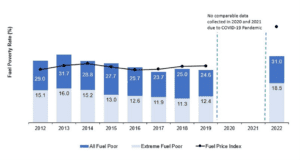- Introduction – our role
The Panel is an independent advisory Non-Departmental Public Body (NDPB), established under The Fuel Poverty (Targets, Definition and Strategy) (Scotland) Act 2019, set up to support Scottish Ministers and others to help eradicate fuel poverty1 in Scotland. The Panel does this by providing an independent voice for Scottish Ministers on fuel poverty matters, fostering co-operation across the fuel poverty landscape, and fulfilling its statutory duty of monitoring Scottish Ministers’ progress towards meeting Scotland’s statutory fuel poverty targets. This includes assessing the likelihood of the Scottish Government meeting those targets, how the four drivers of fuel poverty are being addressed, and how effectively the implementation of Scotland’s Tackling Fuel Poverty Strategy is working to deliver the targets and address the fuel poverty drivers.
2.Fuel Poverty – the context
Scotland faces the challenge of developing and delivering policy to meet its fuel poverty challenge within the context of a wider integrated energy system which covers three separate administrations. There is, of course, commonality in experiences of fuel poverty across the UK. However, the Panel’s view is that Scotland does have particular challenges because of its colder climate, population distribution and lower income levels, and the implications of these for heating needs, accessibility to cheaper energy sources and the means to pay for it.
Fuel Poverty Targets
Scotland’s statutory fuel poverty targets, set out in The Fuel Poverty (Targets, Definition and Strategy) (Scotland) Act, 2019, identify key dates by which Scotland’s fuel poverty rates should reduce (the interim targets) and the date by which fuel poverty should, effectively, be eradicated (they are listed below). Fuel poverty describes the struggle to afford satisfactory levels of energy provision, comfort, and warmth. Scotland’s fuel poverty definition2 2 is based on advice from an independent panel of experts. In Scotland, a household is in fuel poverty if both of the following things are true:
- In order to maintain a satisfactory heating regime, total fuel costs necessary for the home are more than 10% of the household’s adjusted (i.e. after housing costs) net income; (in extreme fuel poverty if more than 20% of the adjusted net income is required) and,
- If, after deducting fuel costs, housing costs, benefits received for a care need or disability, and childcare costs, the household’s remaining adjusted net income is insufficient to maintain an acceptable standard of living.
Scotland’s fuel poverty definition, unlike those in the other administrations, takes account of both the energy efficiency of the home and the household’s financial capacity to heat, and provide energy, according to the needs of the household.
The four administrations across the UK each have a different definition of fuel poverty as well as different targets. This can cause confusion. There are similarities in the definitions but also key points of difference. The UK Government, for example, would not assess someone living in a house with an EPC rating in the A to C range as fuel poor, regardless of their income level or the price of energy. But under the Scottish definition of fuel poverty, low income and high energy prices are key drivers of fuel poverty. To meet Scotland’s targets, overcoming the challenges which these present, in addition to poor energy efficiency and how energy is used in the home, are critical to alleviating and, ultimately, overcoming fuel poverty.
Scotland’s Fuel Poverty Level and Targets
Figure 1: Fuel poverty and extreme fuel poverty rates, Scotland, 2012-2022
Source: Scottish House Condition Survey, 2022

Figure 1, above, shows that in 2022 31% of all Scottish households were estimated to be in fuel poverty, of which 18.5% were estimated to be in extreme fuel poverty. This is a considerable increase on 2019 when 24.6% of Scottish households were estimated to be in fuel poverty and 12.4% were estimated to be in extreme fuel poverty.
Target: In the year 2040, as far as reasonably possible, no household in Scotland is in fuel poverty – no more than 5% of households in Scotland are in fuel poverty, no more than 1% of households in Scotland are in extreme fuel poverty, the median fuel poverty gap is no more than £250.
Interim Targets: In the year 2035, no more than 10% of households in Scotland are in fuel poverty, no more than 3% of households in Scotland are in extreme fuel poverty, and the median fuel poverty gap is no more than £300.
In the year 2030, no more than 15% of households in Scotland are in fuel poverty, no more than 5% of households in Scotland are in extreme fuel poverty, and the median fuel poverty gap is no more than £350.
Fuel Poverty Drivers
The 4 drivers of fuel poverty, identified in The Fuel Poverty (Targets, Definition and Strategy) (Scotland) Act, 2019, go to the heart of the societal challenges which both historically, and now, make fuel poverty a profoundly difficult problem to overcome. Fuel poverty, along with other forms of inter-linked poverty – child and food poverty – lead to physical and mental harms.
- Low incomes leave people unable to afford to heat their homes to a comfortable level, as well as meet other energy requirements for cooking, lighting and, for some, running medical equipment. People may go into energy debt even when energy usage is rationed.
- High energy prices present an affordability threat with some on low incomes feeling compelled to ration or self-disconnect their energy – as well as putting many into debt even when energy usage is rationed.
- Poor energy efficiency of the home means that energy is used inefficiently as no, or sub-standard, insultation, often coupled with expensive heating systems, leave people unable to afford to heat their homes.
- Energy usage in the home, underpinned by behavioural and cultural links, is complex but poor energy literacy, as well as supplier behaviours, can and does lead to under-consumption of energy, and can impact on levels of fuel poverty.
